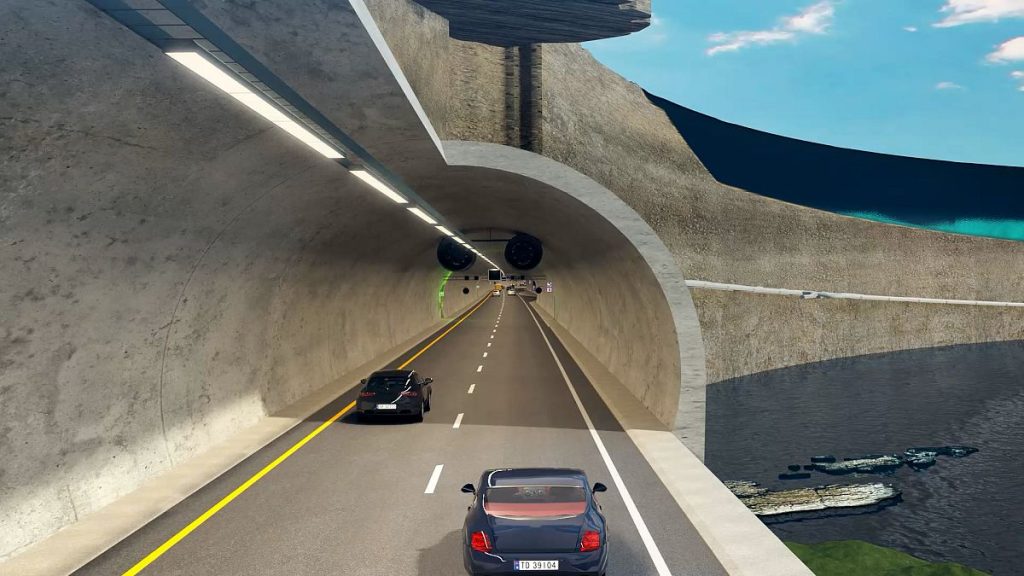Norway is on track to complete the world’s longest and deepest underwater tunnel, known as the Rogfast project, which is a monumental endeavor aimed at enhancing transportation links across the country. Expected to be finished by 2033, the 26.7 km tunnel will significantly reduce travel times between Stavanger and Bergen, two of Norway’s major cities. As construction progresses, the project exemplifies Norway’s expertise in tunnel engineering and its commitment to improving infrastructure.
| Article Subheadings |
|---|
| 1) Overview of the Rogfast tunnel project |
| 2) Key features of the underwater structure |
| 3) Progress and construction methods |
| 4) Economic and environmental impacts |
| 5) The future of Norway’s transportation |
Overview of the Rogfast tunnel project
The Rogfast project is a groundbreaking initiative aimed at creating a fixed link beneath Norway’s majestic fjords. Once complete, it will extend 26.7 kilometers (approximately 16.6 miles) and reach a depth of 390 meters below sea level, making it the longest and deepest underwater tunnel in the world. This significant infrastructure project is intended to bolster transportation connectivity between islands and the mainland, streamlining the travel experience for individuals and industries alike. Major cities like Stavanger and Bergen will particularly benefit, as the tunnel is projected to cut travel time between them by 40 minutes, enhancing accessibility and economic ties.
Key features of the underwater structure
One of Rogfast’s most innovative design elements is its unique intersection point under the island of Kvitsøy, Norway’s smallest municipality. Here, two roundabouts are being constructed 260 meters beneath sea level, which is a first for a subsea construction of this scale. The tunnel will consist of two lanes of traffic flowing in each direction, ensuring a smooth traffic flow. Notably, these roundabouts are designed to facilitate efficient movement, allowing traffic to remain operational even in emergencies, such as closing one lane. This innovative approach to traffic management highlights the project’s commitment to safety and functionality.
Progress and construction methods
Construction of the Rogfast tunnel began in 2018 and has reached the halfway point, with approximately 65% of the northern section completed and 45% of the southern section finished. Utilizing traditional drilling and blasting techniques, Norwegian engineers are excavating solid bedrock to ensure both stability and durability. This method contrasts with other construction projects like the Fehmarn belt, where modular building practices are employed. Norway’s experience in constructing subsea tunnels has made this project a more feasible and cost-effective solution, as the country boasts a history of nearly 40 subsea road tunnels.
Economic and environmental impacts
Upon its completion, the Rogfast tunnel is expected to facilitate approximately 13,000 daily journeys by 2053, significantly enhancing economic activities in the region. The new route will replace ferry crossings, providing a more reliable and efficient mode of transport for both commuters and the seafood industry, which relies on swift access to markets. Not only will travel times improve, but the tunnel is also anticipated to have positive environmental implications by reducing the number of emissions associated with ferry transportation. This strategic infrastructure investment seeks to support local industries while promoting sustainable travel options.
The future of Norway’s transportation
The Rogfast tunnel represents a crucial advancement in Norway’s transportation landscape and aligns with the country’s broader strategy to enhance connectivity across its coastal regions. The Norwegian roads authority emphasizes that the project will not only benefit local economies but also elevate tourism by making popular destinations like Bergen more accessible. As the demand for integrated transport solutions grows, projects like Rogfast are a testament to Norway’s forward-thinking approach in addressing logistical challenges and enhancing public infrastructure. Looking toward the future, this ambitious project will likely serve as a model for similar large-scale infrastructure undertakings around the world.
| No. | Key Points |
|---|---|
| 1 | Rogfast will be the largest and deepest underwater tunnel globally. |
| 2 | The tunnel will facilitate quicker travel between Stavanger and Bergen. |
| 3 | Construction is ongoing, utilizing traditional drilling and blasting methods. |
| 4 | The project aims to enhance economic connectivity and promote environmental sustainability. |
| 5 | Expected completion of the Rogfast tunnel is set for 2033. |
Summary
The Rogfast tunnel is more than just an ambitious engineering feat; it symbolizes Norway’s commitment to improving infrastructure while addressing transportation challenges unique to its geography. By facilitating easier access between key cities, the project is set to have lasting economic, environmental, and social impacts. As construction progresses, the Rogfast project continues to showcase Norway’s expertise in tunnel design and construction, paving the way for future infrastructure innovations worldwide.
Frequently Asked Questions
Question: What is the expected completion date of the Rogfast tunnel?
The Rogfast tunnel is projected to be completed by the summer of 2033.
Question: How will the Rogfast tunnel impact travel times?
The tunnel is expected to reduce travel times between Stavanger and Bergen by 40 minutes.
Question: What construction methods are being used for the Rogfast tunnel?
The tunnel is being built using traditional drilling and blasting techniques through solid bedrock, ensuring stability under water pressure.


